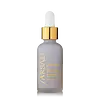What's inside
What's inside
 Key Ingredients
Key Ingredients

 Benefits
Benefits

 Concerns
Concerns

 Ingredients Side-by-side
Ingredients Side-by-side

Water
Skin ConditioningIsopentyldiol
HumectantButylene Glycol
HumectantDimethyl Isosorbide
SolventPPG-24-Glycereth-24
EmulsifyingPEG-40 Hydrogenated Castor Oil
EmulsifyingPolyester-5
Sodium Hyaluronate
HumectantGlycerin
HumectantCitrullus Lanatus Fruit Extract
Skin ConditioningPyrus Malus Fruit Extract
Skin ConditioningLens Esculenta Fruit Extract
Skin ConditioningSodium PCA
HumectantSodium Lactate
BufferingXylitylglucoside
HumectantAnhydroxylitol
HumectantXylitol
HumectantVanilla Planifolia Fruit Water
Skin ConditioningCitrus Aurantium Dulcis Oil
MaskingAmmonium Acryloyldimethyltaurate/Carboxyethyl Acrylate Crosspolymer
Disodium EDTA
Ethylhexylglycerin
Skin ConditioningHydroxyacetophenone
AntioxidantPhenoxyethanol
PreservativeSodium Hydroxide
BufferingSynthetic Fluorphlogopite
CI 77891
Cosmetic ColorantMica
Cosmetic ColorantIron Oxides
Water, Isopentyldiol, Butylene Glycol, Dimethyl Isosorbide, PPG-24-Glycereth-24, PEG-40 Hydrogenated Castor Oil, Polyester-5, Sodium Hyaluronate, Glycerin, Citrullus Lanatus Fruit Extract, Pyrus Malus Fruit Extract, Lens Esculenta Fruit Extract, Sodium PCA, Sodium Lactate, Xylitylglucoside, Anhydroxylitol, Xylitol, Vanilla Planifolia Fruit Water, Citrus Aurantium Dulcis Oil, Ammonium Acryloyldimethyltaurate/Carboxyethyl Acrylate Crosspolymer, Disodium EDTA, Ethylhexylglycerin, Hydroxyacetophenone, Phenoxyethanol, Sodium Hydroxide, Synthetic Fluorphlogopite, CI 77891, Mica, Iron Oxides
Water
Skin ConditioningButylene Glycol
HumectantGlycerin
HumectantDimethicone
EmollientPolysorbate 20
EmulsifyingPhenoxyethanol
PreservativeMica
Cosmetic ColorantHydroxyethyl Acrylate/Sodium Acryloyldimethyl Taurate Copolymer
Emulsion StabilisingPropylene Glycol
HumectantDipropylene Glycol
HumectantEthylhexylglycerin
Skin ConditioningParfum
MaskingDisodium EDTA
Vitis Vinifera Leaf Extract
Skin ConditioningPolysorbate 60
EmulsifyingSorbitan Isostearate
EmulsifyingCocos Nucifera Fruit Extract
EmollientCucumis Sativus Fruit Extract
EmollientCamellia Sinensis Leaf Extract
AntimicrobialTin Oxide
AbrasiveSodium Hyaluronate
HumectantBiosaccharide Gum-1
HumectantIsopropyl Alcohol
SolventBenzyl Benzoate
AntimicrobialLimonene
PerfumingBenzyl Alcohol
PerfumingHydroxycitronellal
PerfumingBenzyl Salicylate
PerfumingHexyl Cinnamal
PerfumingCI 77891
Cosmetic ColorantWater, Butylene Glycol, Glycerin, Dimethicone, Polysorbate 20, Phenoxyethanol, Mica, Hydroxyethyl Acrylate/Sodium Acryloyldimethyl Taurate Copolymer, Propylene Glycol, Dipropylene Glycol, Ethylhexylglycerin, Parfum, Disodium EDTA, Vitis Vinifera Leaf Extract, Polysorbate 60, Sorbitan Isostearate, Cocos Nucifera Fruit Extract, Cucumis Sativus Fruit Extract, Camellia Sinensis Leaf Extract, Tin Oxide, Sodium Hyaluronate, Biosaccharide Gum-1, Isopropyl Alcohol, Benzyl Benzoate, Limonene, Benzyl Alcohol, Hydroxycitronellal, Benzyl Salicylate, Hexyl Cinnamal, CI 77891
Ingredients Explained
These ingredients are found in both products.
Ingredients higher up in an ingredient list are typically present in a larger amount.
Butylene Glycol (or BG) is used within cosmetic products for a few different reasons:
Overall, Butylene Glycol is a safe and well-rounded ingredient that works well with other ingredients.
Though this ingredient works well with most skin types, some people with sensitive skin may experience a reaction such as allergic rashes, closed comedones, or itchiness.
Learn more about Butylene GlycolCi 77891 is a white pigment from Titanium dioxide. It is naturally found in minerals such as rutile and ilmenite.
It's main function is to add a white color to cosmetics. It can also be mixed with other colors to create different shades.
Ci 77891 is commonly found in sunscreens due to its ability to block UV rays.
Learn more about CI 77891Disodium EDTA plays a role in making products more stable by aiding other preservatives.
It is a chelating agent, meaning it neutralizes metal ions that may be found in a product.
Disodium EDTA is a salt of edetic acid and is found to be safe in cosmetic ingredients.
Learn more about Disodium EDTAEthylhexylglycerin (we can't pronounce this either) is commonly used as a preservative and skin softener. It is derived from glyceryl.
You might see Ethylhexylglycerin often paired with other preservatives such as phenoxyethanol. Ethylhexylglycerin has been found to increase the effectiveness of these other preservatives.
Glycerin is already naturally found in your skin. It helps moisturize and protect your skin.
A study from 2016 found glycerin to be more effective as a humectant than AHAs and hyaluronic acid.
As a humectant, it helps the skin stay hydrated by pulling moisture to your skin. The low molecular weight of glycerin allows it to pull moisture into the deeper layers of your skin.
Hydrated skin improves your skin barrier; Your skin barrier helps protect against irritants and bacteria.
Glycerin has also been found to have antimicrobial and antiviral properties. Due to these properties, glycerin is often used in wound and burn treatments.
In cosmetics, glycerin is usually derived from plants such as soybean or palm. However, it can also be sourced from animals, such as tallow or animal fat.
This ingredient is organic, colorless, odorless, and non-toxic.
Glycerin is the name for this ingredient in American English. British English uses Glycerol/Glycerine.
Learn more about GlycerinMica is a naturally occurring mineral used to add shimmer and color in cosmetics. It can also help improve the texture of a product or give it an opaque, white/silver color.
Serecite is the name for very fine but ragged grains of mica.
This ingredient is often coated with metal oxides like titanium dioxide. Trace amounts of heavy metals may be found in mica, but these metals are not harmful in our personal products.
Mica has been used since prehistoric times throughout the world. Ancient Egyptian, Indian, Greek, Roman, Aztec, and Chinese civilizations have used mica.
Learn more about MicaPhenoxyethanol is a preservative that has germicide, antimicrobial, and aromatic properties. Studies show that phenoxyethanol can prevent microbial growth. By itself, it has a scent that is similar to that of a rose.
It's often used in formulations along with Caprylyl Glycol to preserve the shelf life of products.
Sodium Hyaluronate is hyaluronic acid's salt form. It is commonly derived from the sodium salt of hyaluronic acid.
Like hyaluronic acid, it is great at holding water and acts as a humectant. This makes it a great skin hydrating ingredient.
Sodium Hyaluronate is naturally occurring in our bodies and is mostly found in eye fluid and joints.
These are some other common types of Hyaluronic Acid:
Learn more about Sodium HyaluronateWater. It's the most common cosmetic ingredient of all. You'll usually see it at the top of ingredient lists, meaning that it makes up the largest part of the product.
So why is it so popular? Water most often acts as a solvent - this means that it helps dissolve other ingredients into the formulation.
You'll also recognize water as that liquid we all need to stay alive. If you see this, drink a glass of water. Stay hydrated!
Learn more about Water